This website is supported by its readers. If you click one of my links I may earn a commission. I am also a participant in the Amazon affiliates program and I will also earn a commission from qualified purchases.
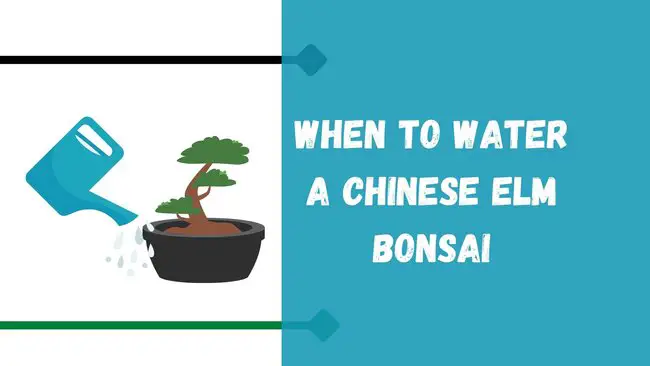
Undoubtedly, one of the most popular bonsai tree species globally has to be the Chinese Elm bonsai. With the tree being prevalent amongst beginner bonsai owners, I’ve had many people ask me when to water a Chinese Elm bonsai?
Chinese Elm Bonsai should be watered once to twice per week. Water once per week during the cold winter and 2 to 3 times per week in the summer. Water a Chinese Elm only when the topsoil is dry to touch.
So precisely how frequently should you water a Chinese Elm bonsai? And do any watering techniques work best? Keep reading to find out more!
Just a quick heads up, over the past three years of running Plantpaladin, hundreds of people have asked for product recommendations. As such, You can find my favorite indoor bonsai tree here (link takes you to Bonsaiboy), my favorite outdoor bonsai tree (link takes you to Bonsaiboy), or have a look at all the products I recommend here.
When to water a Chinese Elm bonsai tree?
One of the best things about Chinese Elm trees is just how beginner-friendly they are.
While they require sunlight, fertilizing, and watering, they can easily be kept indoors, making them ideal for beginners.
One common mistake I have noticed in my time operating Plant Paladin has been just how many people underwater or overwater their bonsai trees.
So when is the best time to water a bonsai tree?
To get to the bottom of this, I got in touch with a few tree experts, visited my local botanical gardens, have grown 3 Chinese Elm bonsai trees myself, and did a quick survey of ten plant paladin readers.
All to ensure you have the most in-depth post possible on when to water a Chinese Elm bonsai.
When to water a Chinese Elm bonsai tree – quick facts
To summarise:
- Most Chinese Elm trees need to be watered once to twice per week.
- It would be best to water with a watering can or hose pipe. Bottom watering using moisture trays can also be done if you are away from your tree for extended periods.
- While the exact amount of watering will vary from Chinese bonsai tree to tree, as a general rule of thumb, only water your Chinese Elm bonsai tree when the topsoil is dry to touch.
- Chinese Elm trees will perform best when the topsoil is moist.
- During the warm summers, Chinese Elm trees will require more watering. You must check if Elm trees need watering multiple times daily.
- Typically, 2 to 3 times will be enough to water a Chinese Elm during the summer.
- During the cold winter, watering should be reduced to once weekly or every two weeks.
- Water can potentially freeze on a Chinese Elm in winter, so mulching should be used to help retain the tree’s water,
- You can also use sphagnum moss to help add further moisture to a Chinese Elm tree.
Now, this is a lot of information to digest, especially if you are a beginner, so let’s break this down in more detail:
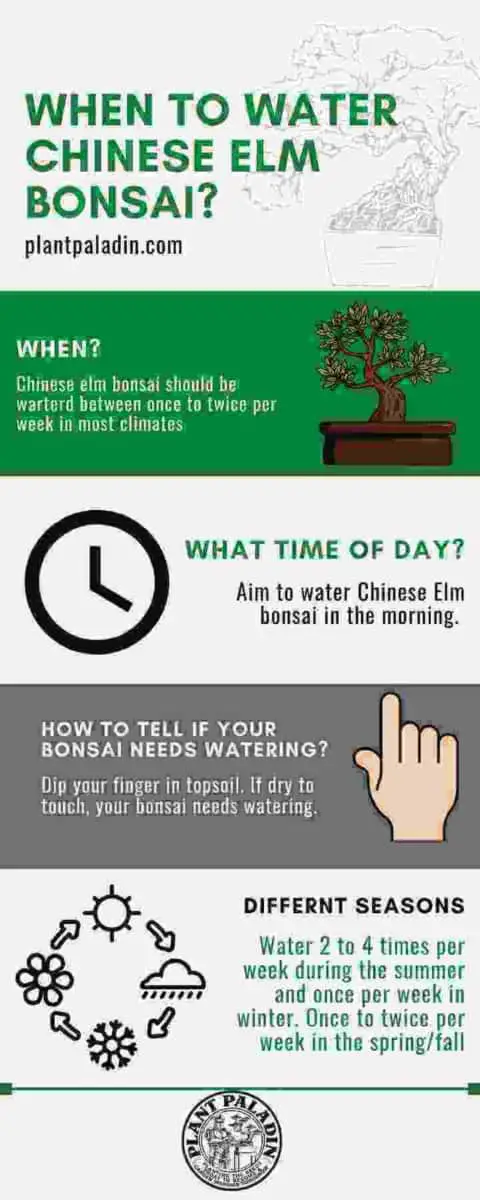
How often do you water a Chinese Elm bonsai?
One of the big problems I had when I started growing bonsai trees was overwatering my Chinese Elms.
I was so hesitant that my trees would die that I would regularly overwater my trees, causing their leaves to turn yellow, lose leaves, and just basically making me stress out even more.
Like most beginner-friendly bonsai trees, the Chinese Elm does not need to be watered frequently. Chinese Elm trees should only be watered once to twice per week if you live in a mild seasonal climate.
The best way to tell if your Chinese Elm tree needs watering is to touch the topsoil; if it is dry to touch (aka, it does not feel moist, and you have not left with wet fingers afterward ), then you need to water your Chinese Elm tree.
Now during the summer, you might need to be more frequently, which is why I recommend checking your Chinese Elm bonsai tree twice daily.
During the winter, you can reduce this to once per day as your Chinese Elm tree will only need to be watered around once weekly or once every two weeks.
How to check if your Chinese Elm bonsai needs watering?
The best method to check if your Chinese Elm tree would be to check its topsoil.
If the topsoil is dry to touch, you must water your tree. Chinese Elm trees grow at their healthiest when the topsoil is moist.
To follow the process, then:
Set a schedule to check your Chinese Elm bonsai
So first, I’d recommend setting up a regular schedule to check your Chinese Elm tree soil.
I like to do this daily during my regular routine but ain for every other day if you do not have the time.
During the summer, you might need to do this twice daily, especially if you are going through a heatwave.
Dip your finger in the soil
Next up, it’s the part that everyone loves to hate.
Using your index finger, dip your finger into your soil.
Ideally, you want to do so that your finger goes about half an inch to and an inch deep in your potting soil.
Leave the food for about 5 to 10 seconds, and then pull your finger out of the soil.
If the soil is dry, then your Chinese Elm bonsai requires watering.
If your finger comes out wet or slightly moist, then your Elm should be okay for another 24 hours.
For peace of mind, you can use finger techniques on multiple spots of the potting soil.
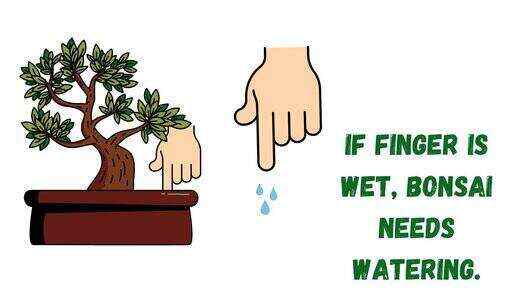
Water your Chinese Elm
If your soil is dry to touch, then water the soil, either with waa watering can or hosepipe or using bottom watering.,
We will cover this in more detail later in the post.
Consider getting new potting soil
It is usual for potting soil to dry out during warm, dry months, even if you keep your Chinese Elm bonsai indoors.
If, however, you are experiencing cooler conditions and your Chinese Elm tree is still drying out, regardless of how often you water your tree- this could be a surefire sign of soil issues.
Repot your Chinese Elm bonsai in new soil with an organic or inorganic soil mix.
The best soil mixes will mix moisture retention, flow, and oxygen.
When to water a Chinese Elm bonsai tree through the seasons?
Most of you reading this do not live in climates where temperatures stay the same year-round, but in mild temperate climates as I do, that change season to season.
As such, It can be challenging to track how often you need to water your Chinese Elm bonsai tree as the season changes.
To summarise, however, I’ve made a table below:
Season | How much watering |
Spring | 1-2 times per week |
Summer | 2 to 4 times per week |
Autumn | 1 to 2 times per week |
Winter | Once per week/every two weeks |
Let’s explore these in more detail:
Spring
So during the spring, Chinese Elm bonsai trees will grow the most.
As such, the temperatures for most of us are neither too warm nor too cold.
The best time to water a Chinese Elm bonsai tree during the spring will be around once to twice per week.
Again, ensure that you use the fingertip method to determine if the topsoil is dry or not.
Summer
When summer arrives, you need to water your Chinese Elm bonsai tree more.
The warm temperatures will mean that the moisture will dry out from your soil much faster than during the other seasons.
I recommend checking your topsoil twice daily, once in the morning and once in the evening, to determine if it needs watering.
I’d also recommend moving your Chinese Elm bonsai into the shade during the warmest brightest parts of the day, which can cause your tree leaves to burn.
As a general rule of thumb, you want to water your Chinese Elm 2 to 4 times per week during hot conditions in the summer.
Autumn
Like spring watering your Chinese Elm bonsai tree once to twice a week in the autumn will typically work best.
Temperatures tend to be slightly warmer during the early autumn than in the cold latter part of the autumn. Be sure to adjust the regularity of watering as you get further into the season.
Potentially start by watering two to 3 times per week and then gradually reduce this to once per week.
Winter
Surprisingly, you only need to water Chinese Elm bonsai once or once every two weeks in the winter.
The caveat to this is if you keep your Chinese Elm bonsai outdoors.
If you do, ensure you add mulch to your topsoil to prevent your tree from getting excessive frost on it.
If you keep your Chinese Elm tree indoors in careful temperature-controlled conditions, then watering once per week will typically be adequate.
How to water a Chinese Elm bonsai tree?
So now you know when to water a Chinese Elm bonsai tree. What exactly are the best steps you can follow to water a Chinese Elm bonsai tree.
Typically, I find the four methods the best to water a Chinese Elm bonsai:
- Using a watering can
- Using a hosepipe
- Spritzing with a spray bottle
- Bottom watering
Let’s explore these in more detail.
Using a watering can
So the most common method to water a Chinese Elm bonsai is to use a watering can.
It’s the most beginner friendly and will ensure you get good coverage across your tree.
To do so, attach the spray nozzle to your watering can so you do not have one solid stream of water but a sprinkle of water.
Move your Chinese Elm bonsai outdoors or to where the water can flow freely underneath the tree.
Then pour the water directly over the leaves of the Chinese Elm bonsai. Water from the leaves will pour out through the drainage holes of the tree.
Aim to water your Chinese Elm tree, depending on the size, for 20 to 40 seconds.
You will have completed watering the tree when the water has started to pour out.
Using a hosepipe
Hospeipes can also be used to water your Chinese Elm bonsai.
The technique is pretty much the same as using a watering can.
The only two caveats to this are
- Use the low-pressure function
- Use the spray nozzle setting
Using the low-pressure function will ensure you do not damage your Chinese Elm tree with a big blast of water.
I would only opt for the high-pressure function if you had an insect infestation such as Aphids on your tree and wanted to blast them away.
I’d also attach the spray nozzle to your hosepipe to prevent your tree from getting hit with one solid stream of water and instead has an even excellent distribution.
Spritzing with a spray bottle
In the summer months, spritzing can also be used to top up the moisture of your Chinese Elm bonsai during the hottest parts of the day.
Using a spray bottle with the watering methods above will yield the best results.
Fill a spray bottle of water, then spray your Chinese Elm tree leaves and topsoil with about 5 to 10 sprays.
Spray bottles work best if you know temperatures will be high and moisture will evaporate quickly from your tree.
Spritzing also works if it is a hot summer day and you will be at work through most of the day.
If this is the case, ensure that the leaves are dripping wet before you leave.
Bottom watering
While bottom watering is not something I would recommend daily, you can use it in certain circumstances.
If you are on vacation and have no one to come over and water your trees, you can use bottom watering on Chinese Elm trees.
Chinese Elm is beginner friendly and resistant enough to overcome most overwatering.
To bottom water, fill up a bowl, sink, or bathtub with enough water to submerge your Chinese Elm trees bonsai pot.
Leave in for around an hour and remove.
Bottom watering typically takes longer for the water to get absorbed into the tree and is perfect for overloading the tree with water before you go on vacation.
A more bonsai-friendly approach to watering using bottom watering would be investing in moisture or humidity trays with a shallow layer of water.
These lead to less of a change of overwatering and can provide a better water distribution in periods of your absence.
Do moisture trays work for Chinese Elm bonsai trees?
Moisture trays can be used for Chinese Elm bonsai trees when you are away from the tree for more extended periods. Moisture or humidity trays will provide a shallow layer of water that can add moisture to the tree while gently watering the soil and roots of your tree.
However, consider only using moisture trays when you are away from your tree for more than a week.
Traditional watering methods such as using a watering can or hose pipe will work best.
How much water should you use when watering a Chinese Elm?
The larger the bonsai, the more water it will require. Chinese Elm bonsai will need between 250ml and 1 liter of water per watering session. Fingertip Chinese Elm bonsai will only need around 250ml of watering per session. Imperial Chinese Elm bonsai may need upwards of 2 liters.
Typically the larger a Chinese Elm bonsai, the more time it will take to water the tree, so when watering, you need to consider the water absorption time too.
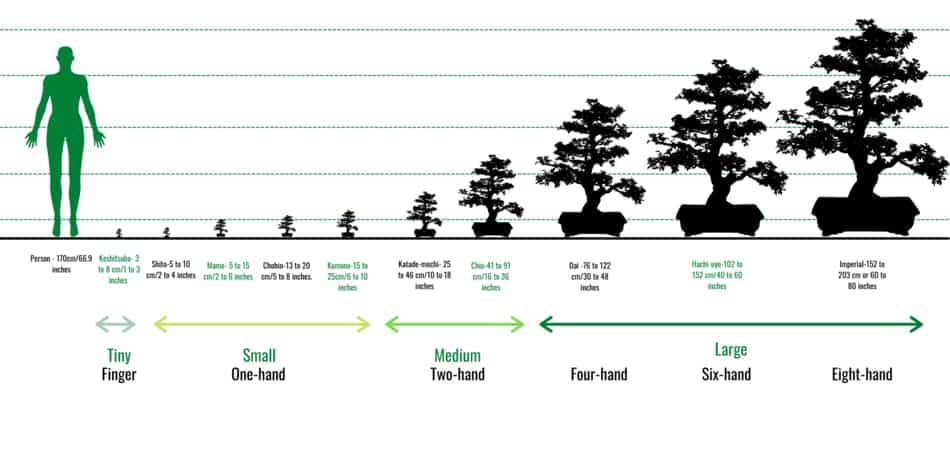
Now, as you can tell, there is a big difference in the ranges of water needed, so to help, I’ve made a table below which should help explain things in more detail:
Classification | How much water per watering session? | Size inches | Size Centimeters | Hand size | General size |
Keshitsubo | 200ml | 1 to 3 inches | 3 to 8 centimeters | Fingertip | Tiny |
Shito | 200ml | 2 to 4 inches | 5 to 10 centimeters | One-hand | Tiny |
Mame | 250ml | 2 to 6 inches | 5 to 15 centimeters | One-hand | Small |
Chohin | 300ml | 5 to 8 inches | 13 to 20 centimeters | One-hand | Small |
Kumono | 300ml to 350ml | 6 to 10 inches | 15 to 25 centimeters | One-hand | Small |
Katade-mochi | 350ml to 400ml | 10 to 18 inches | 25 to 46 centimeters | Two-hand | Medium |
Chiu or Chumono | 400ml to 500ml | 16 to 36 inches | 41 to 91 centimeters | Two-hand | Medium |
Dai or Omono | 500ml to 750ml | 30 to 48 inches | 76 to 122 centimeters | Four-hand | Large |
Hachi-uye | 750ml to 1 liter | 40 to 60 inches | 102 to 152 centimeters | Six-hand | Large |
Imperial | 1 to 2 liters | 60 to 80 inches | 152 to 203 centimeters | Eight-hand | Large |
Should you water a Chinese Elm bonsai with rainwater?
You should use rainwater to water Chinese Elm bonsai if possible. Rainwater contains far fewer harmful chemicals such as fluoride, which can cause a build-up in your tree if too much tap water is used.
Consider investing in rainwater catches and using this water to water your trees as it will not impact the PH level of your soil.
Alternatively, if you do not have rainwater available, and it is financially viable for you to do so, consider investing in a water filter,
Water filters, too, will remove any potential toxins commonly found in tap water.
What is the best location to water a Chinese Elm bonsai?
Watering a Chinese Elm bonsai outdoors on a flat surface is the best location to water a Chinese Elm bonsai. Outdoor watering will allow any excess water to evenly drain from your bonsai pot without the worry of pools of water building up.
Avoid watering your Chinese Elm bonsai in spaces where the water can overflow or damage surrounding areas.
Why is watering Chinese Elm bonsai important?
So you know how and when to water a Chinese Elm bonsai, but why is watering important?
Well, to summarise:
Essential for photosynthesis
Photosynthesis is the process of your tree absorbing sunlight and converting it into food.
Without water, your tree would not have the necessary energy or elements to cover the sunlight into food and transform carbon dioxide into oxygen.
It helps cool trees down
During the hot summer months, managing the temperature of a Chinese Elm tree is half the battle.
Water then allows your tree to undertake a process called transpiration.
During warm days, the moisture from your Chinese Elm bonsai tree leaves will evaporate.
Watering will allow your tree to transport the water from its roots to the leaves, cooling your trees and maintaining a healthy temperature.
It helps transport nutrients
Chinese Elm bonsai use nutrients in the soil such as nitrogen, potassium, and phosphorus to aid their growth.
These nutrients are transported through the inner wood in the tree.
It’s one of the reasons why trees often have sap in them when you cut open their trunks.
Without water, your Chinese Elm bonsai would not have the necessary material to help transport these valuable nutrients to different tree parts.
Problems with not watering your Chinese Elm?
If you fail to water your Chinese Elm bonsai, your tree will not be able to photosynthesize, transport nutrients into your tree, or regulate its temperature correctly. After a few weeks, your leaves and branches will dry and shrink, and your tree will eventually dry.
What to avoid when watering a Chinese Elm bonsai tree?
So hopefully, by reading this article today, you will have a good insight into the best techniques needed to water your Chinese Elm bonsai.
There are a few things that you should avoid when watering your Chinese Elm bonsai, which include:
- Watering too frequently – Avoid watering your Chinese Elm bonsai more than twice per week during most conditions. Watering too frequently can lead to things like root rot.
- Not checking for signs of mold – Overwatering can lead to mold infections. The most common mold infections in Chinese Elm bonsai trees would be those with white spots on your tree’s leaves. If this is the case, use an antifungal to remove this to stop the spread of the infection.
- Using too much water – Chinese Elm trees require much less water than more giant trees. A good rule of thumb would be between 200ml and 1 liter of water.
- Using the wrong tools – Avoid buckets or other tools that provide a lot of water in one go. Instead, use sprinkler nozzles that allow for an even distribution of water across the tree.
Indoor vs. outdoor watering for Chinese Elm bonsai
One element we have not touched upon yet are the differences between watering your Chinese Elm if you keep it indoors vs. outdoors.
Watering indoors
If you keep the temperature roughly the same, you can get away with watering your Chinese Elm bonsai around once or twice per week.
The major challenge, however, of watering your bonsai indoors is simply the dry air.
Even during warm, muggy summers, the air indoors is typically a lot dryer than outdoors.
As such, even if it is raining outdoors, trees indoors can be dehydrating.
It’s essential to check your topsoil daily if you do keep your Chinese Elm bonsai indoors.
I’d also recommend using moisture trays indoors for this very reason.
Watering outdoors
So if you keep your Chinese Elm bonsai tree outdoors, there are a few different perimeters you need to contend with.
~first, you don’t have anywhere near the amount of controlling the temperature compared to indoors.
On top of this, you have the weather to contend with.
Rain is a common occurrence in temperate climates where most of us live.
As such, use common sense.
If it has rained the day before, chances are you won’t need to water your Chinese Elm bonsai the day after.
Check the topsoil twice daily during hotter summers to prevent your tree from drying out.
When to water Chinese Elm bonsai seeds?
If you are growing your Chinese Elm bonsai tree from seed, ensure you don’t overwater your tree.
Take more care if your Chinese Elm tree has just been planted.
As such, check the topsoil around three times per day to ensure you look after the moisture level of your Chinese Elm tree in its first few weeks if growing from seed.
During the stratification process, ensure your seeds are kept moist by using a spritzer or sphagnum moss.
Can you use moss for Chinese Elm bonsai?
Mosses such as sphagnum moss can be used during the summer to add extra moisture to your bonsai. Sphagnum moss can hold up to 8 times its weight in water. Place on the topsoil of your tree.
Using mosses then can be beneficial if you will be away from your tree for a more extended period and need to give some excess moisture to your tree, for example, if you are traveling.
Do you need to water a Chinese Elm tree more than other bonsai?
Chinese Elm bonsai trees require watering once to twice per week. This is less than other bonsai species such as Weeping Willow that need to be watered daily, but more than succulents such as Jade that can be watered once per week.
If you have a different bonsai tree species, I would recommend looking at the table below:
how often to water a bonsai by species
Bonsai Species | How often should topsoil be checked | How often should the bonsai tree be watered |
Weeping Willow | A few times per day | Daily |
Birch | A few times per day | Daily |
Alder | A few times per day | Daily |
Apple | Once per day | A few times per week when not producing fruit. Daily when producing fruit. |
Lemon | Once per day | A few times per week when not producing fruit. Daily when producing fruit. |
Lime | Once per day | A few times per week when not producing fruit. Daily when producing fruit. |
Orange | Once per day | A few times per week when not producing fruit. Daily when producing fruit. |
Crabapple | Once per day | A few times per week when not producing fruit. Daily when producing fruit. |
Cherry | Once per day | A few times per week when not producing fruit. Daily when producing fruit. |
Ficus | Once per day | Daily to a few times per week. |
Chinese Elm | Once per day | Daily to a few times per week. |
Fukien Tea | Once per day | Daily to a few times per week. |
Serissa | Once per day | Daily to a few times per week. |
Olive | Once per day | Daily to a few times per week. |
Juniper | Once per day | Daily to a few times per week. |
Pine | Once per day | Daily to a few times per week. |
Scots Pine | Once per day | Daily to a few times per week. |
Oak | Once per day | Daily to a few times per week. |
Jade | Once per day | Daily to a few times per week. |
Can you overwater a Chinese Elm bonsai?
Overwatering a Chinese Elm bonsai tree is incredibly common and happens if you water your tree more than two to three times per week in mild conditions. Left unchecked overwatering can cause root rot and fungal infections and kill your tree.
If you suspect you have overwatered your bonsai, repot and dry out the tree as soon as possible.
You can do this in many ways, but I would recommend having a look at my post on reviving overwatered bonsai.
Survey
Finally, I asked 20 plant paladin readers who one Chinese Elm bonsai when to water Chinese Elm bonsai.
To summarise:
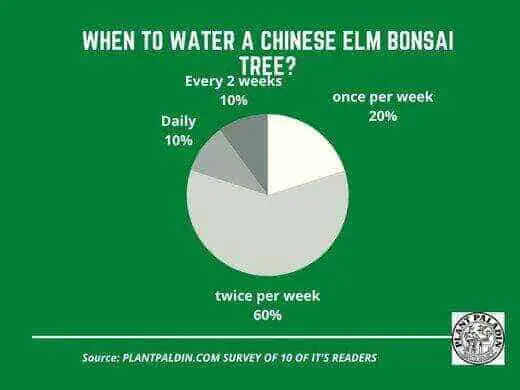
My top picks for the gear you will need!
So like I mentioned earlier, over the past three years of running PlantPaladin, hundreds of people have asked me for my recommendations on the best bonsai gear on the market.
Having spent thousands of dollars on bonsai items these past few years and tested at least 100 bonsai-specific products, I’ve listed my favorite products below – All of which I highly recommend and think you can get great value.
They can purchase directly by clicking the link to take them to Amazon.
Bonsai Tool Set: One of the significant challenges I’ve had is finding a toolset that was not only durable but didn’t break the bank. SOLIGT has recently developed a fantastic bonsai tool set that covers all the tools you need to trim, prune, and repot your trees. – You can grab it here.
Complete Bonsai Set: Many of you will want to grow your bonsai trees entirely from scratch, but finding the varicose seeds, pots, and other items in one place can be challenging. Leaves and Sole then have created a complete bonsai set that I’ve personally used that ticks all the boxes. You can grab it here.
Bonsai wire: The number of times I’ve run out of wire for my bonsai or purchased cheap bonsai wire that doesn’t do the job is embarrassing for me to admit. After a lot of trial and error, I found that using Hotop’s aluminum bonsai wire is one of the best options on the market. This can easily be used for both indoor and outdoor bonsai. You can grab it here.
